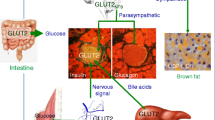Abstract
The binding of the fucose-specific lectin, Ulex europaeus agglutinin (UEA-I), to entero-endocrine cells was studied in the ileum and caecum of humans, rabbits, rats, and mice. In all species investigated, numerous cells scattered in the crypt and villus epithelia intensely bound the UEA-I lectin. These cells proved to be argyrophilic and were identified as enterochromaffin cells and peptide tyrosine tyrosine cells by immunohistochemistry. They mostly reached the gut lumen (”open type”) by slender cellular processes. At the ultrastructural level, fucose binding sites were located in the matrix of the electron-dense secretory granules of these cells and in the glycocalyx covering their apical membrane. The results show that in various mammalian species entero-endocrine cells of defined types express fucose-bearing glycoconjugates. The presence of fucose residues in the apical membrane of entero-endocrine cells indicates that this membrane domain has a specialized composition of intramembranous glycoconjugates which could be involved in receptive and/or secretory functions.
Similar content being viewed by others
Author information
Authors and Affiliations
Additional information
Accepted: 12 June 1997
Rights and permissions
About this article
Cite this article
Gebert, A., Cetin, Y. Expression of fucose residues in entero-endocrine cells. Histochemistry 109, 161–165 (1998). https://doi.org/10.1007/s004180050213
Issue Date:
DOI: https://doi.org/10.1007/s004180050213




